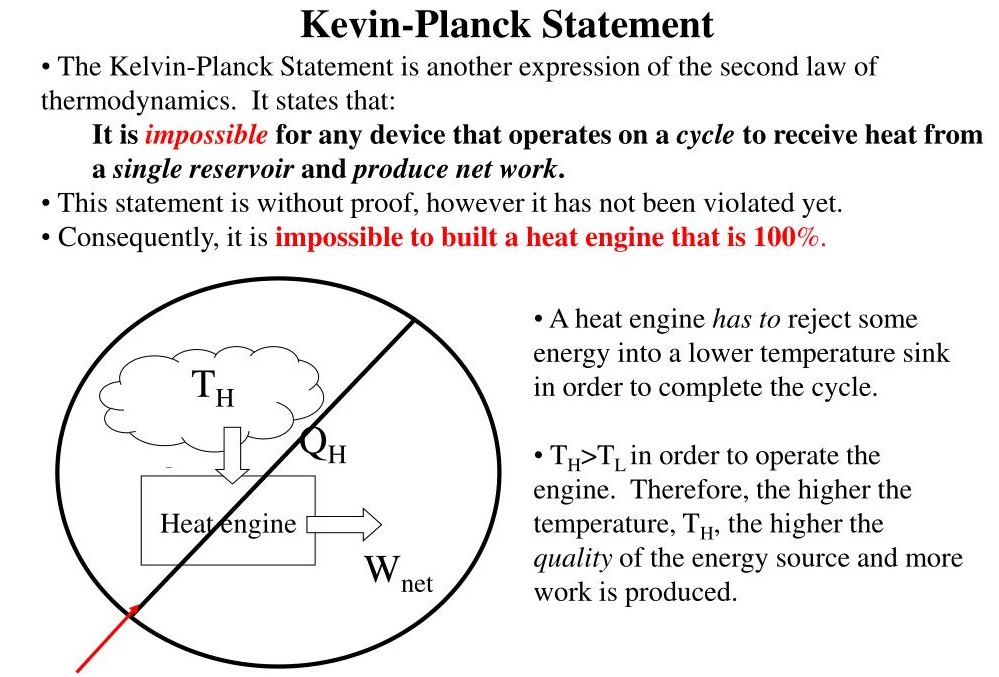
Kelvin-Planck Statement :-Delve into the Kelvin-Planck statement, a cornerstone of thermodynamics, explaining why no heat engine can be 100% efficient and must reject some heat. Explore the implications of this principle and its significance in understanding energy conversion processes.

Kelvin-Planck Statement:-
The Kelvin-Planck statement is a fundamental concept in thermodynamics, specifically pertaining to the Second Law of Thermodynamics. Named after Lord Kelvin (William Thomson) and Max Planck, this statement articulates a crucial limitation on the efficiency of heat engines. To comprehend the Kelvin-Planck statement, it’s essential to grasp its origins and the broader context within the field of thermodynamics.
Lord Kelvin and Max Planck independently contributed to the formulation of the Kelvin-Planck statement during the late 19th and early 20th centuries. This statement addresses the inherent limitations on the efficiency of heat engines – devices designed to convert heat energy into mechanical work. By examining this statement, we gain insights into the nature of energy conversion processes and the irreversibility that characterizes certain thermodynamic phenomena.
The Kelvin-Planck statement
The Kelvin-Planck statement can be succinctly articulated as follows: “No process is possible in which the sole result is the absorption of heat from a reservoir and its complete conversion into work.” This seemingly straightforward statement carries profound implications for the design and operation of heat engines.
At its core, the Kelvin-Planck statement asserts that it is impossible to create a heat engine that operates in a complete cycle, absorbing heat solely from a single reservoir, and converting all of that heat into useful work. In practical terms, this means that for any heat engine to function, it must reject some amount of heat to a lower-temperature reservoir. The statement establishes a critical boundary on the efficiency of heat engines, emphasizing the unavoidable presence of heat dissipation in real-world energy conversion processes.
To understand the statement better, let’s delve into its implications for thermal efficiency. Thermal efficiency is a key parameter in assessing the performance of a heat engine and is defined as the ratio of the work done by the engine to the heat absorbed from the hot reservoir. The Kelvin-Planck statement directly influences this efficiency by stipulating that no heat engine can achieve 100% efficiency. In other words, some heat must be discarded in every thermodynamic cycle.
The significance of the statement becomes apparent when considering the broader context of energy conservation and the irreversibility of natural processes. It underscores the fact that perfect conversion of heat into work is unattainable and highlights the inevitability of energy losses during real-world energy transformations.
The statement has profound implications in various fields, including engineering, physics, and environmental science. Engineers and scientists must grapple with the reality that no heat engine can operate with complete efficiency, prompting the search for innovative technologies and strategies to improve energy conversion processes while minimizing waste heat.
In conclusion, the statement stands as a cornerstone in the edifice of thermodynamics, elucidating the inherent limitations on the efficiency of heat engines. Its proclamation that no process exists where heat is solely absorbed and completely converted into work underscores the irreversibility of certain thermodynamic processes. As we navigate the challenges of energy conversion in the modern world, the Kelvin-Planck statement serves as a guiding principle, reminding us of the intrinsic constraints that shape our understanding of energy and its transformations.
इस कथन का इंजीनियरिंग, भौतिकी और पर्यावरण विज्ञान सहित विभिन्न क्षेत्रों में गहरा प्रभाव है। इंजीनियरों और वैज्ञानिकों को इस वास्तविकता से जूझना होगा कि कोई भी ताप इंजन पूरी दक्षता के साथ काम नहीं कर सकता है, जिससे अपशिष्ट ताप को कम करते हुए ऊर्जा रूपांतरण प्रक्रियाओं में सुधार करने के लिए नवीन प्रौद्योगिकियों और रणनीतियों की खोज को प्रेरित किया जा सके।
अंत में, यह कथन थर्मोडायनामिक्स की इमारत में आधारशिला के रूप में खड़ा है, जो ताप इंजनों की दक्षता पर अंतर्निहित सीमाओं को स्पष्ट करता है। इसकी उद्घोषणा कि ऐसी कोई प्रक्रिया मौजूद नहीं है जहां गर्मी पूरी तरह से अवशोषित होती है और पूरी तरह से कार्य में परिवर्तित हो जाती है, कुछ थर्मोडायनामिक प्रक्रियाओं की अपरिवर्तनीयता को रेखांकित करती है। जैसे ही हम आधुनिक दुनिया में ऊर्जा रूपांतरण की चुनौतियों का सामना करते हैं, केल्विन-प्लैंक कथन एक मार्गदर्शक सिद्धांत के रूप में कार्य करता है, जो हमें उन आंतरिक बाधाओं की याद दिलाता है जो ऊर्जा और इसके परिवर्तनों के बारे में हमारी समझ को आकार देते हैं।
For More information visit web :-https://xeidea.com/
And news website:– https://lokprasang.com/
